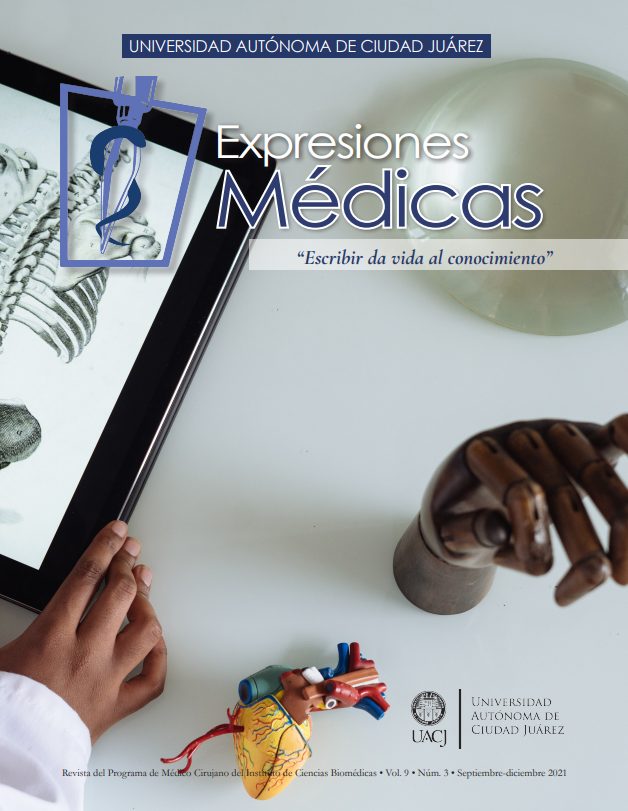Crisis convulsivas de inicio tardío secundarias a tuberculosis cerebelosa. Reporte de un caso y consideraciones acerca de la tuberculosis en México
Palabras clave:
Convulsiones, Crisis, Tuberculosis, Cerebelosa, MéxicoResumen
Se presenta el caso de un paciente masculino, de 27 años de edad, ingresó el 14 de febrero de 2012 con crisis convulsivas tónicoclónicas generalizadas, alteraciones de la marcha y equilibrio de dos meses de evolución. La exploración física evidenció: paciente soporoso, desorientado en tiempo, lugar y persona, con exploración cardiopulmonar y abdominal sin alteración. Una biometría hemática y química sanguínea fueron normales, y la serología contra el virus de inmunodeficiencia humana y contra Treponema fueron negativas. Una tomografía axial computarizada de cráneo (22 de febrero de 2012) mostró una tumoración en el cerebelo con hipodensidad en ambos hemisferios cerebelares y herniación amigdalina. El paciente era adicto a inhalantes, vivía con su abuela y su madre estaba presa en un Centro de Readaptación Social. Se realizó derivación ventrículo-peritoneal y toma de biopsia cerebelosa el 13 de marzo de 2012, que mostró fragmentos de cerebelo con múltiples nódulos coalescentes de tejido granulomatoso con necrosis caseosa, abundantes células epitelioides y gigantes multinucleadas de tipo Langhans; en la tinción de Fite-Faraco, se observaron bacilos ácido alcohol resistentes. Se inició tratamiento antifímico convencional y esteroideo el 16 de marzo de 2012 con excelente respuesta clínica, egresado el 21 de marzo de 2012 (36 días de hospitalización). Se completó un año de tratamiento sin recidiva de crisis convulsivas, con deterioro cognitivo y motor leve como secuelas.
Descargas
Citas
Figueroa JF, Frakt AB, Jha AK. Addressing Social Determinants of Health. Time for a Polysocial Risk Score. jama, 2020; 323: 1553-1554. https://www.doi. org/10.1001/jama.2020.2436
Maani N, Galea S. The Role of Physicians in Addressing Social Determinants of Health. jama, 2020; 323: 1551-1552.
Secretaría de Salud. Situación actual de la tuberculosis. 2016. http://www.cenaprece.salud.gob.mx/programas/ interior/micobacteriosis/descargas/pdf/SituacionActualTB_MEXICO2015.pdf
Gage BJ, Armas J. La tuberculosis en México. Magnitud del daño. Sal. Púb. Méx., 1965; 7: 445-458.
covid-19 National Preparedness Collaborators. Pandemic preparedness and covid-19: An Exploratory Analysis of Infection and Fatality Rates, and Contextual Factors Associated with Preparedness in 177 Countries, from Jan. 1, 2020, to Sept. 30, 2021. Lancet 2022. Published Online February 1, 2022. https://doi.org/10.1016/ S0140-6736(22)00172-6
Rock RB, Olin M, Baker CA, Molitor TW, Peterson PK. Central Nervous System Tuberculosis: Pathogenesis and Clinical Aspects. Clin. Microbiol. Rev., 2008; 21: 243-261. https://www.doi.org/10.1128/CMR.00042-07
Dodd PJ, Osman M, Cresswell FV et al. The Global Burden of Tuberculous Meningitis in Adults: A Modeling Study. plos Glob. Pub. Health, 2021; 1(12): e0000069. https://doi.org/10.1371/journal.pgph.0000069
Hwang JH, Lee KM, Park JE et al. Atypical Cerebral Manifestations of Disseminated Mycobacterium tuberculosis. Front. Neurol., 2017; 8: 462. https://www.doi. org/10.3389/fneur.2017.00462
Nguyen DT, Agarwal S, Graviss EA. Trends of Tuberculosis Meningitis and Associated Mortality in Texas, 2010-2017: A Large Population Based Analysis. plos one, 2019; 14(2): e0212729. https://doi.org/10.1371/ journal.pone.0212729
Dirección General de Epidemiología. Boletín Epidemiológico. Sistema Nacional de Vigilancia Epidemiológica. Sistema Único de Información. Secretaría de Salud. Estados Unidos Mexicanos, 2021; 38: 52. https://www. gob.mx/salud/acciones-y-programas/historico-boletinepidemiologico
Báez-Saldaña AR, Pérez-Padilla JR, Salazar-Lezama LA. Discrepancias entre los datos ofrecidos por la Secretaría de Salud y la Organización Mundial de la Salud sobre tuberculosis en México, 1981-1998. Sal. Púb. Méx., 2003; 45: 78-83.
who. Global Tuberculosis Report, 2021. https://worldhealthorg.shinyapps.io/tb_profiles/?_inputs_&entity_ty pe=%22country%22&lan=%22EN%22&iso2=%22 MX%22
Inegi. Censo de Población y Vivienda 2020. Comunicado de prensa núm. 24/21. https://www.inegi.org.mx/ contenidos/saladeprensa/boletines/2021/EstSociodemo/ResultCenso2020_Nal.pdf
Sánchez-Pérez HJ, Flores-Hernández JA, Jansá JM, Caylá JA, Martín-Mateo M. Pulmonary Tuberculosis and Associated Factors in Areas of High Level Poverty in Chiapas. Int. J. Epidemiol., 2001; 30: 386-393.
Sánchez-Pérez HJ, Hernán MA, Hernández-Díaz S, Jansá JM, Halperin D, Ascherio A. Detection of Pulmonary Tuberculosis in Chiapas, Mexico. Ann. Epidemiol., 2002; 12: 166-172.
Patkar D., Narang J, Yanamandala R, Lawande M, Shah GV. Central Nervous System Tuberculosis: Pathophysiology and Imaging Findings. Neuroimaging. Clin. N. Am., 2012; 22: 677-705. https://www.doi. org/10.1016/j.nic.2012.05.006
Donovan J., Figaji A, Imran D, Phu NH, Rohlwink U, Thwaites GE. The Neurocritical Care of Tuberculous Meningitis. Lancet Neurol., 2019; 18: 771-783. https:// www.doi.org/10.1016/S1474-4422(19)30154-1
Huamaní C, Galindo D, Quijano-Zapata F, Aldave R. Meningoencefalitis tuberculosa con quistes aracnoideos medulares y siringomielia aguda. Rev. Neurol., 2017; 65: 383-384.
Fatoumata BL, Sory SI, Abass CF et al. Cerebral Abscesses of Tuberculosis Origin: Study of 8 Cases at the University Hospital of Conakry. Egypt. J. Neurosurg., 2020; 35: 20. https://doi.org/10.1186/s41984-020- 00090-x
Er M, Ates AS, Abuzaina O, Hasanoglu HC. A Rare Case of Cerebellar and Lung Tuberculosis Coexistence which Presenting Intracranial Mass Symptoms. East J. Med., 2018; 23: 36-39. https://doi.org/10.5505/ ejm.2018.36035
Binesh F, Zahir ST, Bovanlu TR. Case Report. Isolated Cerebellar Tuberculoma Mimicking Posterior Cranial Fossa Tumor. bmj Case Report, 2013. Published Online. https://www.doi.org/10.1136/bcr-2013-009965
Agrawal A, Kakani A, Mahajan SN, Vagha SJ, Acharya S. Letter to the Editor. Paradoxical Manifestation of Cerebellar Tuberculoma. Infect. Dis. Clin. Pract., 2011; 19: 72-74.
Wanjari K, Baradkar VP, Nataraj G, Kumar S. A Rare Case of Tubercular Cerebellar Abscess. Ind. J. Med. Microbiol., 2009; 27: 363-365.
Navarrete C, Rosas KM, Sáez MD, Tenhamm FE, Nogales-Gaete J. Síndrome cerebeloso secundario a granulomas de fosa posterior y tuberculosis multisistémica en un paciente con sida. Rev. Chil. Infect., 2008; 25: 122-126.
Dowdy DW, Basu S, Andrews JR. Is Passive Diagnosis Enough? The Impact of Subclinical Disease on Diagnostic Strategies for Tuberculosis. Am. J. Respir. Crit. Care Med., 2013; 187(5): 543-551. https://www.doi. org/10.1164/rccm.201207-1217OC
Drain PK, Bajema KL, Dowdy D et al. Incipient and Subclinical Tuberculosis: A Clinical Review of Early Stages and Progression of Infection. Clin. Microbiol. Rev., 2018; 31(4): e00021-18. https://www.doi.org/10.1128/ CMR.00021-18
Kendall EA, Shrestha S, Dowdy DW. The Epidemiological Importance of Subclinical Tuberculosis. A Critical Reappraisal. Am. J. Respir. Crit. Care Med., 2021; 203(2): 168-174. https://www.doi.org/10.1164/rccm.202006- 2394PP
Yeon CY, Murray MB. Diabetes Mellitus Increases the Risk of Active Tuberculosis: A Systematic Review of 13 Observational Studies. plos Med., 2008; 5: e152.
Baker MA, Harries AD, Yeon CY et al. Systematic Review: The Impact of Diabetes on Tuberculosis Treatment Outcomes. bmc Med., 2011; 9: 81. https:// www.doi.org/10.1186/1741-7015-9-81
Harries AD, Satyanarayana S, Kumar AMV et al. Epidemiology and Interaction of Diabetes Mellitus and Tuberculosis and Challenges for Care: A Review. pha, 2013; 3: S3-S9.
Nathella P, Babu S. Influence of Diabetes Mellitus on Immunity to Human Tuberculosis. Immunology, 2017; 152: 13-24.
Alfarisi O, Mave V, Gaikwad S et al. Effect of Diabetes Mellitus on the Pharmacokinetics and Pharmacodynamics of Tuberculosis Treatment. Antimicrob. Ag. Ch., 2018; 62: e01383-18.
Descargas
Publicado
Cómo citar
Número
Sección
Licencia
Derechos de autor 2022 Luis Javier Casanova Cardiel, Roberto Caro del Castillo, Elías Abbud Abbud

Esta obra está bajo una licencia internacional Creative Commons Atribución 4.0.



